Digital Poster
AD: Molecular & Metabolic Imaging
ISMRM & ISMRT Annual Meeting & Exhibition • 10-15 May 2025 • Honolulu, Hawai'i

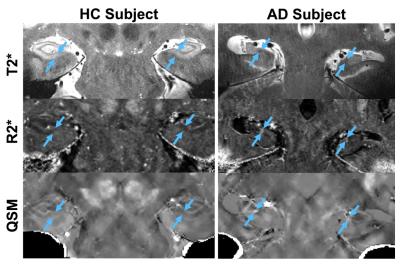 |
Computer Number: 129
1785. Ultra-high
Resolution in vivo 7T MRI Detects Hippocampal Subfield Iron in
Mild Cognitive Impairment and Alzheimer’s Disease
R. Dunne, H. Taghavi, P. DiGiacomo, J. Maclaren, M. Bell, M.
Carlson, E. Mormino, V. Henderson, P. Spincemaille, H.
Zhuang, Y. Wang, B. Rutt, M. Georgiadis, M. Zeineh
Stanford University, Stanford, United States
Impact: This study successfully performed in
vivo ultra-high resolution MRI to quantify iron
deposition in hippocampi of MCI and AD patients,
contributing to the development of iron as a neuroimaging
biomarker for AD.
|
|
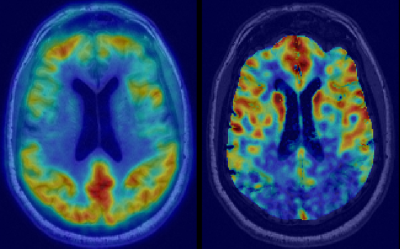 |
Computer Number: 130
1786. Cerebral
metabolic rate of oxygen (CMRO2) is associated with Tau
deposition in older individuals
H. Zhuang, L. Zhou, X. Wang, E. Tanzi, M. de Leon, Y. Li, P.
Spincemaille, I. Kovanlikaya, T. Nyugen, Y. Wang, G. Chiang
Cornell University, Ithaca, United States
Impact: Negative association observed between tau
deposition and oxygen metabolism at both subject and
regional levels extend understanding of the neurotoxity of
tau accumulation, potentially helps to the development of
tau targeted disease modifiers.
|
|
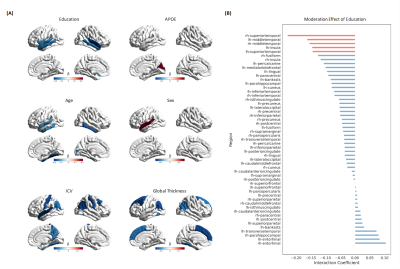 |
Computer Number: 131
1787. Determinants
of Cognitive and Brain Resilience to Reduced Neuronal Metabolism
in Alzheimer’s Disease: A Longitudinal Whole-Brain MRSI Study
W. Li, M. Zhang, Y. Zhao, Y. Li, W. Jin, Y. Zhang, J. Hu,
Z-P Liang, Y. Li
Shanghai Jiao Tong University, Shanghai, China
Impact: Education and brain volume moderated the impact
of impaired neuronal metabolism on cognitive decline, with
education also moderated the effect on brain resilience.
These findings suggest that education may be protective
against cognitive decline and brain atrophy despite neuronal
dysfunction.
|
|
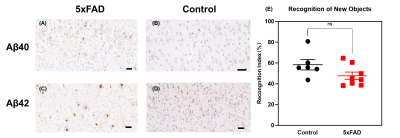 |
Computer Number: 132
1788. Impaired
Glucose Metabolism Detected In Six-month-old 5xFAD Mice Using
Deuterium MRI
G. Yang, Q. Wan, L. Zou, H. Peng, L. Wan, Z. Xu, Y. Li, X.
Liu
Paul C. Lauterbur Research Center for Biomedical Imaging, Shenzhen Institute of Advanced Technology, Chinese Academy of Sciences, Shenzhen, China
Impact: This
study demonstrates the potential of deuterium MRI to detect
early alterations in brain energy metabolism. Noninvasive
evaluation of oxidative metabolism may provide valuable
perspective of AD progression, which can help to identify
potential interventions to slow its progression.
|
|
 |
Computer Number: 133
1789. Mapping
Brain Tissue Sodium Concentration in Cognitively Unimpaired
Elderly Subjects: a 7T Sodium MRI study
A. Haeger, S. Romanzetti, F. Boumezbeur, J. Lagarde, M.
Sarazin, J. Schulz, K. Reetz, M. Bottlaender
RWTH University Hospital, Aachen, Germany
Impact: 23Na-MRI imaging may be a sensitive tool to
discriminate between physiological cerebral aging and
decline during pathological processes.
|
|
 |
Computer Number: 134
1790. Investigation
of Iron Deposition Metabolism in Alzheimer’s Disease in
Hippocampal Subregions using QSM-MRI
D. Li, J. He, L. Zhu, Y. Yang, L. Nie, R. Wang
Medical College, Guizhou University, Guiyang, China
Impact: The reduction in volume (neuronal loss) coupled
with increased iron deposition in specific subregions offers
insights into the mechanisms of neuronal ferroptosis and
serves as a reference for personalized treatment strategies.
|
|
 |
Computer Number: 135
1791. Age
and sex-related changes of the GSH level of the striatum in
healthy individuals as revealed with proton magnetic resonance
spectroscopy
Y. Zhang, N. He, P. Wu, J. Weng, F. Yan
Ruijin Hospital, Shanghai Jiao Tong University School of Medicine, Shanghai, China, Shanghai, China
Impact: This study offered a baseline of GSH level in
the striatum which provided a reference for further research
regarding the degree of oxidative stress.
|
|
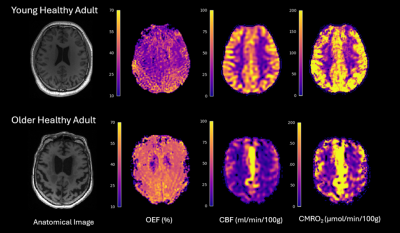 |
Computer Number: 136
1792. Age
Dependence of Brain Oxygen Metabolism Assessed by 3D Constrained
Quantitative BOLD MRI
K. Jaroszynski, H. Lee, M. Langham, J. Detre, F. Wehrli
University of Pennsylvania, Philadelphia, United States
Impact: This study demonstrates the sensitivity of
c-qBOLD MRI to variations in cerebral oxygen metabolism. It
is the first to investigate this method as a radiation-free,
noninvasive, and spatially resolved method for monitoring
age related changes in metabolism.
|
|
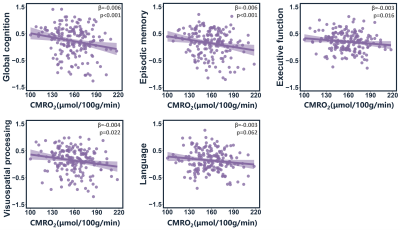 |
Computer Number: 137
1793. Relationship
between brain oxygen metabolism and cognition in older adults
J. Wu, K. Oishi, A. Soldan, C. Pettigrew, Z. Lin, Y. Zhu, D.
Jiang, X. Li, A. Moghekar, P. Liu, K. Oishi, M. Albert, H.
Lu
Johns Hopkins University School of Medicine, Baltimore, United States
Impact: The present work suggests that, at the very
early stage of Alzheimer’s disease, higher brain oxygen
metabolism is a sign of lower cognitive function, reflecting
brain's hypermetabolism/hyperactivity during preclinical
neurodegeneration.
|
|
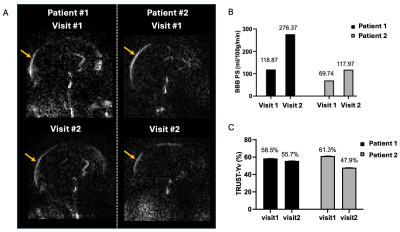 |
Computer Number: 138
1794. ARIA
Evaluation: physiological hallmarks of vascular alterations in
patients undergoing anti-amyloid therapy
Z. Sun, L. Jiang, H. Pang, C. Li, H. Lu, T. Wisniewski, Y.
Ge
NYU Grossman School of Medicine, New York, United States
Impact: Advanced MRI techniques for assessing BBB
permeability and venous oxygenation offer a quantitative
approach in detecting early vascular and metabolic changes
linked to anti-amyloid treatment, providing valuable
insights and tools for monitoring amyloid-related imaging
abnormalities (ARIA) and assessing ARIA risk.
|
|
 |
Computer Number: 139
1795. Interrogating
Aging Progression and Early Detection of Alzheimer’s Disease
Using Metabolic Imaging
J. Zickus, J. Enriquez, M. Wang, B. Sun, X. Qiu, S.
Goodwani, J. Wefel, D. Piwnica-Worms, S. Gammon, J. Ray, P.
Bhattacharya
The University of Texas MD Anderson Cancer Center UTHealth Houston Graduate School of Biomedical Sciences, Houston, United States
Impact: Early detection of Alzheimer’s disease employing
hyperpolarized metabolic imaging may facilitate early
intervention to prevent dementia, elucidate the metabolic
pathology of the disease, and improve treatment outcome
through monitoring of treatment efficacy.
|
|
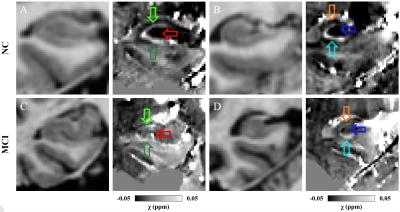 |
Computer Number: 140
1796. Increased
susceptibility in the anterior hippocampal dentate gyrus and CA4
region of patients with mild cognitive impairment
G. Zheng, Y. Huang, S. Mazumder, F. Yu, P. Unschuld, X. Li,
J. Liu
UT Southwestern Medical Center, Dallas, United States
Impact: Investigating iron accumulation in the
hippocampal subregions with high spatial resolution using
7T holds promise for the early detection of abnormalities in
Alzheimer's disease and for enhancing our understanding of
the underlying pathological mechanisms.
|
|
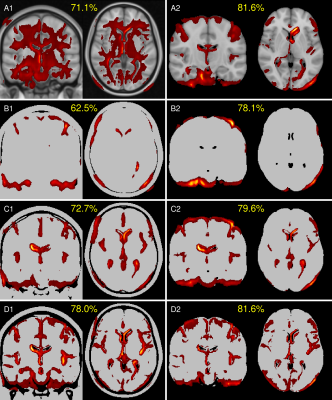 |
Computer Number: 141
1797. Clever
Hans effect found in a widely used Alzheimer's Disease MRI
dataset
C. Tinauer, M. Sackl, S. Ropele, C. Langkammer
Medical University of Graz, Graz, Austria
Impact: The identification of biases learned by deep
neural networks for disease classification using only
structural MR images enables validation of the models and
improves reliability.
|
|
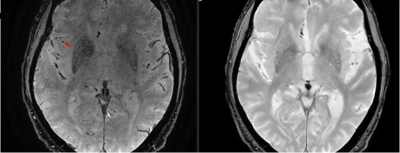 |
Computer Number: 142
1798. 3D
EPI Performance in Detecting Microhemorrhage, Compared to 2D GRE
I. Langenfeld, D. Rettmann, B. Fernandez, T. Sprenger, S.
Banerjee, S. Messina, P. Cogswell
GE HealthCare, ROCHESTER, United States
Impact: The introduction of 3D EPI as a fast, highly
sensitive pulse sequence for detecting microhemorrhages
could aid in MRI-based diagnosis in neurodegenerative
diseases.
|
|
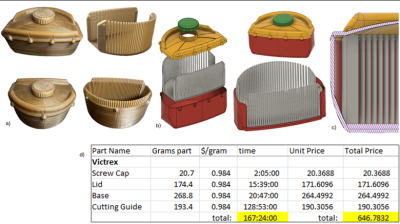 |
Computer Number: 143
1799. Postmortem
High-Resolution 7T MRI in a Reusable 3D-Printed enclosure with
cutting guides for registration with gross anatomy
J. Berardinelli, J. Kofler, J. Li, J-J Liou, T. Santini, M.
Wu, J. Mettenburg, M. Ikonomovic, H. Aizenstein, T. Ibrahim
University of Pittsburgh, Ben Avon, United States
Impact: This 3D-printed brain container and cutting
guide enhance postmortem imaging precision and WMH
segmentation, offering consistent high-resolution imaging,
efficient histological processing, and potential adaptation
for other non-chambered organs in anatomical studies.
|
|
 |
Computer Number: 144
1800. Alterations
of cortical and subcortical structures in mild cognitive
impairment
J. Wang, X. Liang, B. Zhang
Nanjing Drum Tower Hospital, Nanjing, China
Impact: These findings highlight the significance of
structural alterations in brain regions associated with
memory impairment in individuals with MCI, and could be
helpful for the early identification and clinical diagnosis
of MCI.
|
The International Society for Magnetic Resonance in Medicine is accredited by the Accreditation Council for Continuing Medical Education to provide continuing medical education for physicians.